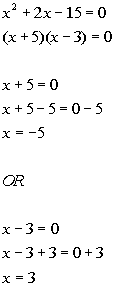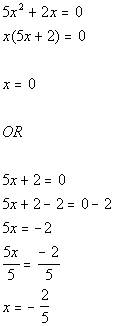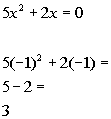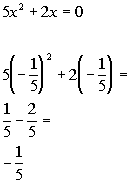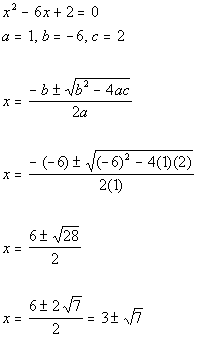How to Find the Solution Set of a Quadratic Inequality
College Algebra
Tutorial 23A: Quadratic Inequalities
WTAMU > Virtual Math Lab > College Algebra
![]() Learning Objectives
Learning Objectives
After completing this tutorial, you should be able to:
-
Solve quadratic inequalities using a sign graph of factors.
-
Solve quadratic inequalities using the test-point method.
![]() Introduction
Introduction
In this tutorial we will be looking at solving quadratic inequalities using two different methods. We will be revisiting solving quadratic equations to help solve the quadratic inequalities. If you need a review on solving quadratic equations, feel free to go to Tutorial 17: Quadratic Equations. I think we are ready to start.
![]() Tutorial
Tutorial
A quadratic inequality is one that can be written in one of the following standard forms:
![]()
or
![]()
or
![]()
or
![]()
In other words, a quadratic inequality is in standard form when the inequality is set to 0.
Just like in a quadratic equation, the degree of the polynomial expression is two.
Using a Sign Graph of the Factors
This method of solving quadratic inequalities only works if the quadratic factors. If it doesn't factor then you will need to use the test-point method shown later on this page.
Step 1: Write the quadratic inequality in standard form.
It is VERY important that one side of the inequality is 0.
0 is our magic number. It is the only number that separates the negatives from the positives. If an expression is greater than 0, then there is no doubt that its sign is positive. Likewise, if it is less than 0, its sign is negative. You can not say this about any other number. Since we are working with inequalities, this idea will come in handy. With this technique we will be looking at the sign of a number to determine if it is a solution or not.
Step 2: Solve the quadratic equation,![]() , by factoring to get the boundary point(s).
, by factoring to get the boundary point(s).
The boundary point(s) will mark off where the quadratic expression is equal to 0. This is like the cross over point. 0 is neither positive or negative.
If you need a review on how to solve a quadratic equation, feel free to go to Tutorial 17: Quadratic Equations.
As mentioned above, this method of solving quadratic inequalities only works if the quadratic factors. If it doesn't factor then you will need to use the test-point method shown later on this page.
Step 3: Use the boundary points found in Step 2 to mark off test intervals on the number line and list all of the factors found in Step 2.
The boundary point(s) on the number will create test intervals.
Step 4: Find the sign of every factor in every interval.
You can choose ANY value in an interval to plug into each factor. Whatever the sign of the factor is with that value gives you the sign you need for that factor in that interval. Make sure that you find the sign of every factor in every interval.
Since the inequality will be set to 0, we are not interested in the actual value that we get when we plug in our test points, but what SIGN (positive or negative) that we get.
Step 5: Using the signs found in Step 4, determine the sign of the overall quadratic function in each interval.
Since the inequality will be set to 0, we are not interested in the actual value that we get when we plug in our test points, but what SIGN (positive or negative) that we get.
When you look at the signs of your factors in each interval, keep in mind that they represent a product of the factors that make up your overall quadratic function.
You determine the sign of the overall quadratic function by using basic multiplication sign rules:
-
The product of two factors that have the same sign is positive.
-
The product of two factors that have the opposite signs is negative.
If the quadratic expression is less than or less than or equal to 0, then we are interested in values that cause the quadratic expression to be negative.
If the quadratic expression is greater than or greater than or equal to 0, then we are interested in values that cause our quadratic expression to be positive .
Step 6: Write the solution set and graph.
 Example 1: Solve using a sign graph of factors, write your answer in interval notation and graph the solution set:
Example 1: Solve using a sign graph of factors, write your answer in interval notation and graph the solution set:![]() .
.
View a video of this example
Step 1: Write the quadratic inequality in standard form.
This quadratic inequality is already in standard form.
Step 2: Solve the quadratic equation ,![]() , by factoring to get the boundary point(s).
, by factoring to get the boundary point(s).
| | *Set 1st factor = 0 and solve *Set 2nd factor = 0 and solve |
-5 and 3 are boundary points.
Below is a graph that marks off the boundary points -5 and 3 and shows the three sections that those points have created on the graph. Note that open holes were used on those two points since our original inequality did not include where it is equal to 0.

Note that the two boundary points create three sections on the graph:![]() ,
,![]() , and
, and![]() .
.
You can choose ANY point in an interval to represent that interval. Remember that we are not interested in the actual value that we get, but what SIGN (positive or negative) that we get.
If we chose a number in the first interval, ![]() , like -6 (I could have used -10, -25, or -10000 as long as it is in the interval), it would make both factors negative:
, like -6 (I could have used -10, -25, or -10000 as long as it is in the interval), it would make both factors negative:
-6 + 5 = -1 and -6 - 3 = -9
If we chose a number in the second interval,![]() , like 0 (I could have used -4, -1, or 2 as long as it is in the interval), it would make
, like 0 (I could have used -4, -1, or 2 as long as it is in the interval), it would make
+ 5 positive and
x- 3 negative:
If we chose a number in the third interval, ![]() , like 4 (I could have used 10, 25, or 10000 as long as it is in the interval), it would make both factors positive:
, like 4 (I could have used 10, 25, or 10000 as long as it is in the interval), it would make both factors positive:

In the first interval, ![]() , we have a negative times a negative, so the sign of the quadratic in that interval is positive.
, we have a negative times a negative, so the sign of the quadratic in that interval is positive.
In the second interval, ![]() , we have a positive times a negative, so the sign of the quadratic in that interval is negative.
, we have a positive times a negative, so the sign of the quadratic in that interval is negative.
In the third interval, ![]() , we have two positives, so the sign of the quadratic in that interval is positive.
, we have two positives, so the sign of the quadratic in that interval is positive.
Keep in mind that our original problem is![]() . Since we are looking for the quadratic expression to be LESS THAN 0 , that means we need our sign to be NEGATIVE .
. Since we are looking for the quadratic expression to be LESS THAN 0 , that means we need our sign to be NEGATIVE .

It looks like the only interval that this quadratic is negative is the second interval, ![]() .
.
| Interval notation: Graph: | *Open interval indicating all values between -5 and 3 *Visual showing all numbers between -5 and 3 on the number line |
 Example 2: Solve using a sign graph of factors, write your answer in interval notation and graph the solution set:
Example 2: Solve using a sign graph of factors, write your answer in interval notation and graph the solution set:![]() .
.
View a video of this example
Step 1: Write the quadratic inequality in standard form.
| | *Inv. of sub. 6 x squared is add. 6 x squared |
Step 2: Solve the quadratic equation ,![]() , by factoring to get the boundary point(s).
, by factoring to get the boundary point(s).
| | *Factor *Set 1st factor = 0 and solve *Set 2nd factor = 0 and solve |
-5/2 and -1/3 are boundary points.
Below is a graph that marks off the boundary points -5/2 and -1/3 and shows the three sections that those points have created on the graph. Note that closed holes were used on those two points since our original inequality includes where it is equal to 0.

Note that the two boundary points create three sections on the graph:![]() ,
,![]() , and
, and![]() .
.
You can choose ANY point in an interval to represent that interval. Remember that we are not interested in the actual value that we get, but what SIGN (positive or negative) that we get.
If we chose a number in the first interval, ![]() , like -4 (I could have used -10, -25, or -10000 as long as it is in the interval), it would make both factors negative:
, like -4 (I could have used -10, -25, or -10000 as long as it is in the interval), it would make both factors negative:
2(-4) + 5 = -3 and 3(-4) + 1 = -11
If we chose a number in the second interval, ![]() , like -1 (I could have used -2, -3/2, or -1/2 as long as it is in the interval), it would make 2
, like -1 (I could have used -2, -3/2, or -1/2 as long as it is in the interval), it would make 2
+ 5 positive and 3
x+ 1 negative:
2(-1) + 5 = 3 and 3(-1) + 1 = -2
If we chose a number in the third interval, ![]() , like 0 (I could have used 10, 25, or 10000 as long as it is in the interval), it would make both factors positive:
, like 0 (I could have used 10, 25, or 10000 as long as it is in the interval), it would make both factors positive:
2(0) + 5 = 5 and 3(0) + 1 = 1

In the first interval, ![]() , we have a negative times a negative, so the sign of the quadratic in that interval is positive.
, we have a negative times a negative, so the sign of the quadratic in that interval is positive.
In the second interval, ![]() , we have a positive times a negative, so the sign of the quadratic in that interval is negative.
, we have a positive times a negative, so the sign of the quadratic in that interval is negative.
In the third interval, ![]() , we have two positives, so the sign of the quadratic in that interval is positive.
, we have two positives, so the sign of the quadratic in that interval is positive.
Keep in mind that our inequality is![]() . Since we are looking for the quadratic expression to be GREATER THAN OR EQUAL TO 0 , that means we need our sign to be POSITIVE (OR O) .
. Since we are looking for the quadratic expression to be GREATER THAN OR EQUAL TO 0 , that means we need our sign to be POSITIVE (OR O) .

It looks like there are two intervals where the quadratic is positive, the first, ![]() , and the third,
, and the third, ![]() .
.
| Interval notation: Graph: | *Closed intervals indicating all values less than or equal to -5/2 or greater than or equal to -1/3 *Visual showing all numbers less than or equal to -5/2 or greater than or equal to -1/3 |
Using the Test-Point Method
The test-point method for solving quadratic inequalities works for any quadratic that has a real number solution, whether it factors or not.
Step 1: Write the quadratic inequality in standard form.
It is VERY important that one side of the inequality is 0.
0 is our magic number. It is the only number that separates the negatives from the positives. If an expression is greater than 0, then there is no doubt that its sign is positive. Likewise, if it is less than 0, its sign is negative. You can not say this about any other number. Since we are working with inequalities, this idea will come in handy. With this technique we will be looking at the sign of a number to determine if it is a solution or not.
Step 2: Solve the quadratic equation,![]() , to get the boundary point(s).
, to get the boundary point(s).
The boundary point(s) will mark off where the quadratic expression is equal to 0. This is like the cross over point. 0 is neither positive or negative.
If you need a review on how to solve a quadratic equation, feel free to go to Tutorial 17: Quadratic Equations.
Step 3: Use the boundary point(s) found in step 2 to mark off test intervals on the number line.
The boundary point(s) on the number will create test intervals.
Step 4: Test a point in each test interval found in step 3 to see which interval(s) is part of the solution set.
You can choose ANY point in an interval to represent it. You need to make sure that you test one point from each interval. Sometimes more than one interval can be part of the solution set.
Since the inequality will be set to 0, we are not interested in the actual value that we get when we plug in our test points, but what SIGN (positive or negative) that we get.
If the quadratic expression is less than or less than or equal to 0, then we are interested in values that cause the quadratic expression to be negative.
If the quadratic expression is greater than or greater than or equal to 0, then we are interested in values that cause our quadratic expression to be positive.
Step 5: Write the solution set and graph.
 Example 3: Solve using the test-point method , write your answer in interval notation and graph the solution set:
Example 3: Solve using the test-point method , write your answer in interval notation and graph the solution set:![]() .
.
View a video of this example
Step 1: Write the quadratic inequality in standard form.
This quadratic inequality is already in standard form.
Step 2: Solve the quadratic equation ,![]() , to get the boundary point(s).
, to get the boundary point(s).
| | *Set 1st factor = 0 and solve *Set 2nd factor = 0 and solve |
-2/5 and 0 are boundary points.
Below is a graph that marks off the boundary points -2/5 and 0 and shows the three sections that those points have created on the graph. Note that closed holes were used on those two points since our original inequality includes where it is equal to 0.

Note that the two boundary points create three sections on the graph:![]() ,
,![]() , and
, and![]() .
.
Step 4: Test a point in each test interval found in step 3 to see which interval(s) is part of the solution set.
You can choose ANY point in an interval to represent that interval. Remember that we are not interested in the actual value that we get, but what SIGN (positive or negative) that we get.
Keep in mind that our original problem is![]() . Since we are looking for the quadratic expression to be LESS THAN OR EQUAL TO 0 , that means we need our sign to be NEGATIVE (OR 0) .
. Since we are looking for the quadratic expression to be LESS THAN OR EQUAL TO 0 , that means we need our sign to be NEGATIVE (OR 0) .
From the interval![]() , I choose to use -1 to test this interval:
, I choose to use -1 to test this interval:
(I could have used -10, -25, or -10000 as long as it is in the interval)
| | *Chose -1 from 1st interval to plug in for x |
Since 3 is positive and we are looking for values that cause our quadratic expression to be less than or equal to 0 (negative or 0),![]() would not be part of the solution.
would not be part of the solution.
From the interval![]() , I choose to use -1/5 to test this interval.
, I choose to use -1/5 to test this interval.
(I could have used -1/6, -1/7, or -1/8 as long as it is in the interval)
| | *Chose -1/5 from 2nd interval to plug in for x |
Since -1/5 is negative and we are looking for values that cause our expression to be less than or equal to 0 (negative or 0),![]() would be part of the solution.
would be part of the solution.
From the interval![]() , I choose 1 to use to test this interval.
, I choose 1 to use to test this interval.
(I could have used 10, 25, or 10000 as long as it is in the interval)
| | *Chose 1 from 3rd interval to plug in for x |
Since 7 is positive and we are looking for values that cause our quadratic expression to be less than or equal to 0 (negative or 0),![]() would not be part of the solution.
would not be part of the solution.
| Interval notation: Graph: | *Closed interval indicating all values between -2/5 and 0, inclusive *Visual showing all numbers between -2/5 and 0, inclusive |
 Example 4: Solve using the test-point method , write your answer in interval notation and graph the solution set:
Example 4: Solve using the test-point method , write your answer in interval notation and graph the solution set:  .
.
View a video of this example
Step 1: Write the quadratic inequality in standard form.
| | *Inv. of sub. 2 is add. 2 |
Step 2: Solve the quadratic equation ,![]() , to get the boundary point(s).
, to get the boundary point(s).
Since  cannot be solved by factoring, how can we find the solution?
cannot be solved by factoring, how can we find the solution?
How about using the quadratic formula?
| | *Identify a , b , and c *Quadratic formula *Plug in values for a , b , and c into formula |
 and
and are boundary points.
are boundary points.
Below is a graph that marks off the boundary points  and
and and shows the three sections that those points have created on the graph. Note that open holes were used on those two points since our original inequality does not include where it is equal to 0.
and shows the three sections that those points have created on the graph. Note that open holes were used on those two points since our original inequality does not include where it is equal to 0.

Note that the two boundary points create three sections on the graph:  ,
, , and
, and  .
.
Step 4: Test a point in each test interval found in step 3 to see which interval(s) is part of the solution set.
You can choose ANY point in an interval to represent that interval. Remember that we are not interested in the actual value that we get, but what SIGN (positive or negative) that we get.
Keep in mind that our original problem is  . Since we are looking for the quadratic expression to be GREATER THAN 0 , that means we need our sign to be POSITIVE.
. Since we are looking for the quadratic expression to be GREATER THAN 0 , that means we need our sign to be POSITIVE.
From the interval  , I choose to use 0 to test this interval:
, I choose to use 0 to test this interval:
(I could have used -10, -25, or -10000 as long as it is in the interval)
Note that  is approximately .35.
is approximately .35.
| | *Chose 0 from 1st interval to plug in for x |
Since 2 is positive and we are looking for values that cause our quadratic expression to be greater than 0,  would be part of the solution.
would be part of the solution.
| | *Chose 1 from 2nd interval to plug in for x |
Since -3 is negative and we are looking for values that cause our expression to be greater than 0,  would not be part of the solution.
would not be part of the solution.
From the interval  , I choose 6 to use to test this interval.
, I choose 6 to use to test this interval.
(I could have used 10, 25, or 10000 as long as it is in the interval)
Note that  is approximately 5.65.
is approximately 5.65.
| | *Chose 6 from 3rd interval to plug in for x |
Since 2 is positive and we are looking for values that cause our quadratic expression to be greater than 0,  would be part of the solution.
would be part of the solution.
| Interval notation: Graph: | *Open intervals indicating all values less than *Visual showing all numbers less than |
![]() Practice Problems
Practice Problems
These are practice problems to help bring you to the next level. It will allow you to check and see if you have an understanding of these types of problems. Math works just like anything else, if you want to get good at it, then you need to practice it. Even the best athletes and musicians had help along the way and lots of practice, practice, practice, to get good at their sport or instrument. In fact there is no such thing as too much practice.
To get the most out of these, you should work the problem out on your own and then check your answer by clicking on the link for the answer/discussion for that problem. At the link you will find the answer as well as any steps that went into finding that answer.
Practice Problems 1a - 1b: Solve (using any method), write your answer in interval notation and graph the solution set.
![]() Need Extra Help on these Topics?
Need Extra Help on these Topics?
![]()
Videos at this site were created and produced by Kim Seward and Virginia Williams Trice.
Last revised on Dec. 30, 2009 by Kim Seward.
All contents copyright (C) 2002 - 2010, WTAMU and Kim Seward. All rights reserved.
How to Find the Solution Set of a Quadratic Inequality
Source: https://www.wtamu.edu/academic/anns/mps/math/mathlab/col_algebra/col_alg_tut23_quadineq.htm
